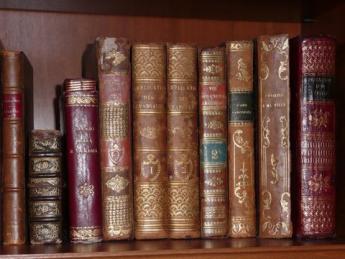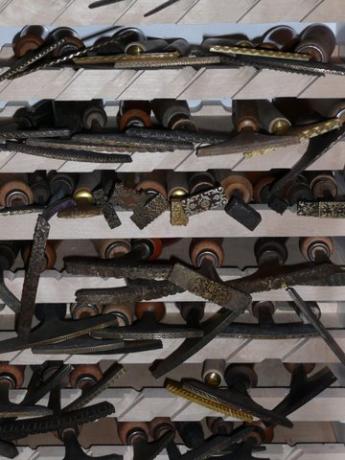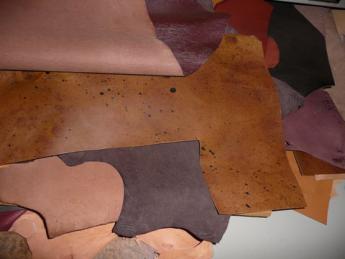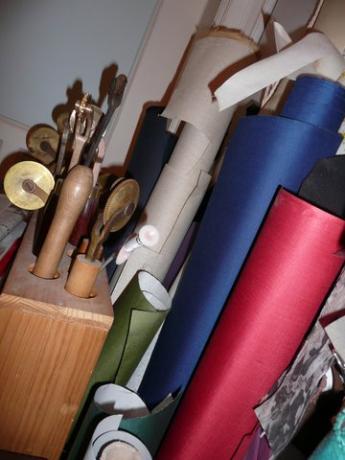The Unavoidable: The Restoration of Books

Geneviève von Hahn
Thoughts from a restorer: A quick look at the shelves or the show cases of exhibitors at antiquarian fairs shows how well books can withstand the bite of time. Whether the property of collectors or of libraries, many incunabula have braved the centuries without a wrinkle. Of course, we are not completely naive. It is obvious that the books shown to the possible customer are those which have least suffered and the backrooms are probably filled with poor souls that would require all our empathy.
Officially, antiquarians never buy nor possess books in less than pristine condition. Privately, they jealously keep the address of their restorer whose task it is to erase, in the secret of his workshop, the sorrow traces of maltreatment suffered by those who, because of value or scarcity, still deserve to be put on the market. Therefore, we might as well accept the obvious: one always needs a restorer. And, since it is as with your dentist, you only know he was incompetent after the fact, here are a few pieces of advice that should help avoid costly disappointment.
First, a few basic principles:
The worst enemies of books are water, humidity, polluted atmosphere, insects and poor handling by their users. Against all these culprits, it is not too difficult to protect the books. No water should ever come into contact with leather except under the authority of a professional hand. Don´t keep books in humid areas. Insalubrious cellars, gloomy basements, non-heated storage rooms, garages or any other location where you would refuse to spend winter are to be avoided. Let air circulate behind your shelves by leaving a few centimeters of space between them and the wall. Nothing is better than a bit of fresh air.
Against insects, treat them as you do for your woolens: a few mothballs or equivalent, camphor, pepper, cloves, turpentine, well proven grandmother’s remedies, should create an uncomfortable enough atmosphere for all kinds of specialized insects.
As far as the human predator is concerned, one has to educate him: no dirty hands, coffee cups nor sandwich in the vicinity , no books left open for days, no voluminous objects between pages (newspaper articles, dried flowers or ill placed pencil), no volume forgotten under the full sun in a show window, no removing from a shelf by pulling at the head cap, no perilous stacking only waiting to collapse, knocking corners and tearing joints, no elegant contraptions to keep the last book in the row from falling without book stand – you will find an irremediably twisted back!
All these small attentions plus a regular dusting as well as a light treatment of the leather parts (see below for details) every 2 or 3 years should ensure the health of your bindings. When unfortunately, indelicate maneuvers or careless hands have already caused the damage, there remains nothing else to do than but to call the doctor. It is then yours to judge the situation. However, the intervention of a specialist is unavoidable when:
- The actual functioning of the book is endangered, the pages are loose, the text block is coming apart, the boards are detached.
- Parts of the binding are threatening to go astray: small pieces of the back if not the entire back are falling off, the headbands are dangling free, corners are yawning, the tooling is flaking off, the joints are split, the leather is moldy or even decomposing,
- The esthetic of the binding is gravely diminished by scratches, stains, discolorations , snags and tears that make the selling of the book improbable and its ownership unenviable
- The paper is torn, fragile, stained and/or moldy.
The above list is not exhaustive. The problem is then to know whom to entrust with the task, to decide with her/him which measures are needed to restore the book to its initial function and to check that the work has been properly accomplished.
A few common sense rules for a satisfactory book restoration:
Make sure that the bookbinder you are talking to knows what an old book represents. Probe his knowledge: is he aware of the differences in structures according to time and origin, test him on the dating of the volumes you are about to put between his hands. It is always comforting when he can date a binding within 20 years and distinguish between a German and an English one. Does he have an appropriate assortment of leather for restoration (unfortunately these are always the most expensive) and a wide choice of old or handmade papers. Do you see a reference library or documentation in his work shop he can refer to, when in doubt about a technique, a product, a style or a gilding tool, etc.? If you feel confident with what you observed, you can start discussing the restoration.
It would be wise to have a prior idea of what you want the restoration to achieve so that your book finds it old look and does not lose its soul. Any decision about a specific treatment requires a solid knowledge of book history, value and tradition. Furthermore, it should always be clear that the techniques used are adapted to the material and not the other way round.
It is self evident that one cannot eliminate all marks of time on a book, they probably are what give it its charm: patina, dust, traces of frequent use, hand written notes in the margins, exlibris, corners slightly scuffed, uneven lines, faded gilding and even the spelling mistakes in the titling, all these details belong to it and there is no reason to correct them.
In contrast, all wounds should be healed, making sure that the original substance is preserved as much as possible, keeping interventions to a minimum, scrupulously collecting all witness to the history of the book (notes or writing inside the boards, labels, special constructions, etc.) while using appropriate materials: handmade papers for any book prior to the 19th century, for example, reversible glues, good quality leathers, handmade marbles papers faithful to the original style, handmade headbands. The expense incurred by choosing high quality materials may seem unduly high but it is always justified on the long term. Make sure that your binder is aware of the relation between the costs of, say, 10 cm² of restoration calf, his hourly wage and the value of the book. Any savings by using too modern materials, cheaper but inadequate would be as ill advised as a huge restoration on a worthless book.
In principle, any repair should be reversible without loss to the book. It has been seen that a clumsy restoration, leaving all original elements of the book under it, proved more respectful than a more professional intervention which departed with too much of the substance, leaving only a sorry ghost.
An important thing not to forget is to provide the binder with a list of what should not be done under any circumstance: trim the edges, change the endpapers, replace the covering paper, wash the pages, remove all spots, anything which would denature the book without improving its functioning. And, please, trust him if he does not recommend such or such measure he finds too radical: in this case, he is probably right.
A last fundamental point:
Numerous scientific studies now show that, contrary to prevailing opinion, leather, damaged or not, should neither be treated with lubricating greasy waxes nor saddle soaps. These products use water which is one of the worse culprits for leather deterioration or grease which do not regenerate leathers and tend on the contrary to attract and fix damaging dusts and particles to the surface. For, whatever the treatment, a degenerated leather will never regain its original condition.
A wax such as the cire 213 from the CNRS, used by the French National Library, spread sparingly, will provide some renewed flexibility to slightly worn leather. For leathers very chafed or infected by red rot, only a strengthening of the surface can be considered. The best results seem to be obtain, in state of today’s knowledge, by applying KLUCEL G in conjunction with SC6000, a product designed by the Leather Conservation Center of Northampton, that contains natural and synthetic waxes plus an acrylic resin.
For the protection of leather surfaces in good condition or already strengthened by the previous method, the main objective is to limit absorption of gaseous pollutants in order to slow down the degradation. Good results have been obtained with application of SC6000 or The RENAISSANCE wax. The research laboratories of all big national libraries around the world are looking into the risks inherent to using these products. We will keep you informed of any development.
I hope to have contributed, with these bits of advice, to your ability to take a decision about the unavoidable restoration of many an old book. I am at your disposal to answer any question and provide any information that may be of use on the subject.
Geneviève von Hahn
Einbandkunst . Reliure . Restauration
Holbeinstraße 18
60596 Frankfurt
Germany
or :
Logis de La Chaussée
F-79200 Gourgé
France
Wax
SC6000 Acrylic wax, The leather Conservation Center, lcc@northampton.ac.uk, or, same product : SC7400, Sarl Peltier, Renovcuir@wanadoo.fr
RENAISSANCE Wax, Picreator Enterprises Ltd, www.Picreator.co.uk
Cire 213, Cnrs, www.bnf.fr
KLUCEL G, hydroxypropylcellulose, dissolved in isopropyl alcohol or methylated spirit



